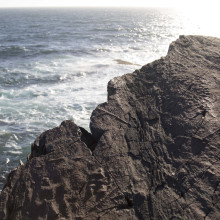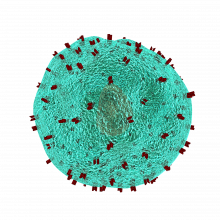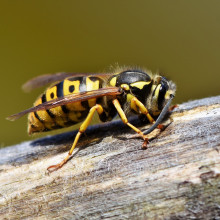Breakthrough in low carbon cement, and static sensitive bugs
In this edition of The Naked Scientists: How science can help cut the carbon footprint of concrete; designer antibodies to introduce cancers to immune assassins; and the caterpillars that sense static charge on wasp wings to beat a hasty retreat…
In this episode

00:56 - Combined cement and steel process halves carbon footprint
Combined cement and steel process halves carbon footprint
Cyrille Dunant, University of Cambridge
Making cement is one of the world’s largest single contributors of greenhouse gas emissions. The iron and steel industry is also a big player owing to the energy it consumes. So the announcement this week by Cambridge engineers, that they’ve developed a way to use old - waste - concrete to remove impurities in the steel-making process, and at the same time produce new cement looks set to be a huge gamechanger. Essentially you’re more than halving the total energy cost! The work - just published in Nature - will hopefully transform the industry. The author, Cyrille Dunant, is at the University of Cambridge’s Department of Engineering…
Cyrille - When you make cement, which is the bit that contains all the CO2 energy in concrete, you need to produce the heat and that means burning stuff. But the ingredients with cement emits CO2 when you burn them. So you must fix those two things. One, you must find ingredients that don't release CO2 when you burn them. And the second one is you need to find a way of producing the heat without burning coal or petrol or any other thing emitting CO2. To do that, we found a source of the key ingredient we need is calcium. Lime and in all cement, from concrete that's already been used and then demolished is without CO2. So that's our source of lime. And for the heat, there's basically one way of making heat that is not carbonated, and that's electricity. But therein lies another problem. Producing very high temperatures with electricity is extremely difficult. And there we've been lucky because it turns out there is a high temperature process that is electric that exists at scale and that's the one we use to recycle steel. And so the idea was can we piggyback on this existing industrial process to make new cement and recycle the old cement that we've collected?
Chris - Are you talking about using old cement in steel making and getting some new cement out in the process or are you talking about using the same system that we use to make steel but It just makes cement sometimes instead?
Cyrille - No, you make both at once because when you make steel you need to add stuff on it to clean it up and the stuff you add, it turns out there's also lime base. And if you put in the minimum amount of lime you can get away with to make new steel, you tweak it, you up a bit, the amount of lime, so that you get the right composition to make cement. It turns out you will get cement and steel at once. So the idea is you can produce at the same time in the same machine, both steel and cement. And the source of lime we use of course is the old cement.
Chris - My GCSE chemistry level of understanding of this was that we would put calcium based material into these furnaces because it reacts with the impurities and it produces slag which floats to the top and we can then spoon that off. So in your process, do you end up not with so much slag but with cement floating there on top of the metal then?
Cyrille - That's right. What we call slag is just stuff floating on top of molten metal. In this instance, the nature of this slag is in fact cement.
Chris - Wow. But how do you not end up with cement contaminated with all the other rubbish that was in the metal? Because there will be trace elements, there will be other things in there. So do you end up with impure less good grade cement or is this the kind of thing that Blue Circle or CMEX will be very happy to put in a bag and send to a housing development?
Cyrille - So the first thing to understand is the impurity you get from the steel making point of view is silica, which is the other big ingredient in cement. So for the point of your cement, it's not an impurity, it's a key ingredient. You also get the trace elements as you mentioned. They're not so much of them and they don't matter all that much. So that's a small fraction of it. The big difference is some of this steel will end up in the cement and so your cement will be slightly lower grade but it will be very close indeed. In fact it'll be something like 80% the same.
Chris - It's a genius idea because you basically burn the energy whether it's electricity or whatever once, and you get two products for the price of one in energy terms. So that sounds ingenious, but have you demonstrated this is feasible at scale? Have you gone to something like the kinds of plants that Tata are talking about building in South Wales that are producing massive quantities and demonstrating that this is viable at that sort of scale?
Cyrille - So we've done it at the lab scale. We've done it at a pilot scale. So there's a step between the big big plant and the sort of lab type of equipment. So we've done that. So that produces about a tonne of the stuff. And at the end of this week the plan is we'll try it at a larger scale. If all goes well, we'll produce something like 60 tonnes of the stuff in about two hours.
Chris - And so what do you think then the dent you can make in the carbon footprint of cement making is?
Cyrille - So it depends a bit on the kind of steel you recycle because some steel is very dirty and you need to add some pure lime to compensate for that. Some steel is very clean. We think the worst possible case, we will reduce the carbon footprint of cement by about two thirds. And the best possible case is actually less CO2 than just recycling steel.

06:18 - Earliest animals could have driven Cambrian explosion
Earliest animals could have driven Cambrian explosion
Emily Mitchell, University of Cambridge
During the Cambrian explosion, roughly 530 million years ago, in a very short time we went from a small number of animal species to nearly every body plan that exists today. It could well be the most important period in the history of animal life. So how did it happen? To find out, scientists have modelled the habits of the animals that existed in the period just before this explosion, known as the Ediacaran, and, incredibly, the activity of these first animal life forms may have helped set the conditions necessary for this explosion of life to occur. To find out how, our colleague Will Tingle went to meet Emily Mitchell who is the curator of the Cambridge University Zoology museum’s non-insect invertebrate gallery…
Emily - The animals in the study are some of the very first animals to have ever existed. So they predate the ability to move around, they predate predation, they can't swim. They lived attached to the sea floor, upright in the water column, feeding on nutrients in the water a little bit like sponges or corals.
Will - How do we know this then?
Emily - We have the most amazing fossil record for the Ediacaran in terms of preservation. We have what's known as exceptional preservation because what we have is hundreds of square metres of fossils preserved under volcanic ash. So it's a little bit like Pompeii in that this underwater ash came down and smothered them all where they were living.
Will - It seems to be quite the anomaly when it comes to being able to study the fossil record because, in general, let's call it what it is, it's a bit rubbish. But it sounds like you've hit the jackpot, as it were, being able to look at these with such fantastic detail.
Emily - I'm not sure I'd call the fossil record rubbish, but I do think that the preservation in the Ediacaran is really, really special. What's particularly interesting about it and useful for it is, because we have this census of Ediacaran life at the time, we can use all sorts of techniques that normally are only really applicable today where we have these full communities and apply them back to the Ediacaran and work out what's going on within the communities and with evolution.
Will - So how have you done it then? How have you gone from admittedly very well preserved, very old fossils, to be able to say that these were similar to sponges, you can almost talk about how they lived their lives?
Emily - Something that I've used that we've utilised within this particular study is looking at how the fossils are positioned on the rock surface. So, because they're immobile and because they're preserved where they lived, the position of the fossil on the rock surface captures all their life history traits: how they got there, how they reproduced, how they interacted with their local environment and how they interacted with each other. So then we can use different sorts of spatial statistics to analyse these patterns. By comparing to different sorts of known reproductive competitive environmental patterns today, we can work out what's driving their patterns and processes. That's relevant in terms of this particular study because we used another technique, which is known as computational fluid dynamics, coupled these spatial patterns to reconstruct the communities.
Will - Now we come to the interesting bit, which is that, as you say, these organisms are churning up the sediment and the fluids around them. What kind of effect is that having on the wider ecosystem?
Emily - So this is really interesting to think about. Before the Ediacaran, the oceans were what's known as rather stratified in that, nowadays, you have very well mixed oceans, whereas back before the Ediacaran it was very, very stratified. You had layers of oxygenated water and layers of anoxic - water without oxygen - and so what these organisms may have potentially been able to do is start to mix up the water. So, beyond their immediate environment, the water was starting to mix and mix and mix, potentially helping to spread the nutrients round to a greater range of areas.
Will - And the big question, then, as you've alluded to this whole time, is that obviously this is the point just before the Cambrian explosion, just before the biggest, perhaps the most important radiation of life on earth. We've now realised that we've got these organisms being able to churn out all these nutrients, destratify the oceans. Do you think there's a link between these organisms and then suddenly this huge burst of life?
Emily - What I think is going on is you have many different processes, potentially, during the Ediacaran, and they all contribute to the radiation we see in the Cambrian. And so things like mixing the water column are the first time organisms have started to have a really strong impact on their local environment beyond just themselves. We think of microbial colonies, it's not really going to affect the large area. Then, through time and throughout the Ediacaran, the animal's ability to impact their local environment changes. So it starts with this potential increase of vertical mixing of the water, then, as they start to move, they start to be able to churn up the sediment, start mixing the substrate, the seafloor beneath them. Then, just at the end of the Ediacaran, before the Cambrian, you start to see biomineralisation and reefs, they start building hard parts. Then, they have the ability to impact their local environment, not only during their lives, but further. All these different processes and these different ways that animals are changing their environment and potentially making it easier for other organisms to live, potentially creating new niches and new potential for new organisms and animals to live in.
Will - Not to be dramatic then, but all of life on Earth has some strange looking cabbages 550 million years ago to thank for existing?
Emily - I think that might be taking it a bit far, if I'm honest, but life on earth, most of life on Earth has been microbial and is microbial. So life has existed on Earth for, you know, pretty much 4 billion years, but it's only around 600 million years ago that we start seeing complex life in animals. So bacterial life would continue very happily. But in terms of other animals, I think that these were very much the first animals and how they lived and how they impacted the environment undoubtedly would have impacted the rest of early animal evolution.

13:05 - Artificial antibody guides cancer to immune execution cells
Artificial antibody guides cancer to immune execution cells
Christiane Stadler, BioNTech
We have developed many different ways of fighting cancer, from chemotherapy to radiotherapy; more recently we’ve begun to harness our own immune systems to attack tumours too. And because the immune system can access all areas and is pre-made to work with our tissues, it’s a logical way forward. To make the process as effective as possible, the same team of scientists from the company BioNtech, which developed one of the Covid vaccines, have now come up with a way to use their mRNA vaccine technology to introduce the genetic instructions for making special modified antibodies - called bispecific antibodies - that can lock onto two things at once: they bind simultaneously onto tumour cells AND grab hold of specific immune cells capable of killing them; by bringing the two together like this, the immune system is stimulated to attack the tumour much more powerfully. The lead author on the study is BioNTech’s Christiane Stadler…
Christiane - Our aim was to get the patient's immune system directly to the site of the tumour by using the technology of bispecific antibodies. Bispecific antibodies are capable of redirecting immune cells to tumour cells.
Chris - Can you just tell us a bit about what a bispecific antibody is? Just paint a picture for us of what one is, what one does, how I would recognise one.
Christiane - Sure. So our bispecific antibodies we are talking about here have a kind of 'y' shape, but that's a little smaller than natural antibodies. And it has two arms binding to a tumour antigen and has one arm that binds to a molecule on T cells. It's called CD3. And this antibody can function like a bridge between tumour cells and T cells.
Chris - It's almost like introducing the victim to its executioner.
Christiane - Exactly. You got it. So, we have everything in our body that we need to kill cancer cells. However, cancer cells are pretty smart and know how to evade the immune system. They're hiding, they're not showing their mutations, so the immune system is kind of blind. Therefore bispecific antibodies are one tool in helping to make these mutated cells visible again and get the cytotoxic T cells directly to the tumour.
Chris - Presumably you've got some kind of molecule or marker on the surface of the cancer cell that the antibody can recognise, which is unique to the cancer.
Christiane - That's correct. So, in our case we use Claudin 6, and Claudin 6 is the surface molecule or antigen of cancer cells. The great thing about Claudin 6 is that it is exclusively expressed on cancer cells, but not on any adult normal tissue apart from the placenta. In humans, Claudin 6 is expressed during embryogenesis, which explains also the expression in the placenta, but then it's completely silenced and absent from adult tissue, which makes it very safe as a target.
Chris - So the rationale here is, we come up with these antibodies, they go around the body, they would lock onto a T cell capable of killing a cancer cell, and they would lock onto a cancer cell, introduce the two together, and this would help the immune system to obliterate the cancer in the body.
Christiane - Exactly. That's the way it works. You bridge the two and T cells get activated and they release a lot of molecules to really kill the cancer cells. And then the T cells proliferate, they become more and more and it's a very highly active system.
Chris - So the key question is, how do you make these antibodies in the first place?
Christiane - This is very different actually in our company. So, 12 years ago we started to implement the RNA technology for antibodies. That's actually how the whole RNA business started at BioNTech. We thought that we could directly inject RNA that carries the genetic information for the therapeutic antibodies into patients so the liver produces the protein. The liver cells would take up the RNA and produce the antibody, release it to the bloodstream, then we could save a lot of time in manufacturing, have a quicker development for patients, and also we could have a longer half life of the bispecific antibodies in the blood because these are small proteins that get eliminated quickly. But since this action of translation in the liver cells goes on for several days, we get a longer sustainable expression of our antibody.
Chris - So you basically have engineered the genetic message for what you want the antibody to recognise on each side of itself - the T-cell and the cancer cell - you put the genetic message in to the bloodstream and liver cells helpfully make those antibodies for you, chuck them into the bloodstream and then they go around the body for a while doing this job.
Christiane - That's the way it works. Yes.
Chris - And does it work?
Christiane - It works. So first we started of course in individual systems, cell cultures, and we saw that cells are able to assemble beautiful antibodies. Then, we went to the mouse for preclinical studies. You always have to use an animal model. And here we intravenously inject the RNA, holding the information for the antibody, and this RNA is packed into lipids to protect it. After intravenous injection, it's delivered to the liver. In the blood we can detect the antibody, but we can also see when we inject human tumours to the mice that these tumours get eliminated. So it's working.
Chris - Are there any risks from doing this? Is it possible you could end up with too much of these antibodies and they could start to cause a runaway immune response or they could prime the immune system to attack something it shouldn't?
Christiane - There's no risk to prime the immune system to attack anything else. However, as always with antibody therapies, it can be too much. So this is carefully investigated by different dose levels: how high can we go? But since we have this tumour exclusive target, Claudin 6, the risk of any adverse events is really, really low. But bispecific antibodies and activating T cells, you always have to be a little careful to not overshoot the cytokine release. This has been carefully monitored but, in our case, the risk is lower than usual.

19:58 - Caterpillars sense electric field from wasp wingbeats
Caterpillars sense electric field from wasp wingbeats
Sam England, University of Bristol
In the natural world, detecting a predator early, or getting the drop on your prey, is often the difference between life and death. This multimillion-year-old arms race has led to the evolution of giant noise detecting ears, and eyes that can see nearly a full 360 degrees. But now, scientists are uncovering another world of predator-prey interactions that make use of another field of senses: electroreception. A study from the University of Bristol has found that a wasp’s wingbeats generate enough of an electrical charge to be detected by the caterpillars they prey on, giving these caterpillars a heads up that danger is nearby. Author on the study Sam England explains…
Sam - Animals in nature pretty readily accumulate static charge when they rub up against leaves or, or the air or sand or other things in their environment. And just in the same way that electrostatically charged balloons can move your hair around, we were wondering whether or not the natural static charges of animals could move the hairs around on other animals and whether those animals could feel that. And the really obvious application of this is, well, could a prey animal like a caterpillar detect the static charge of a predator animal like a wasp?
Chris - What scale of static buildup accumulates on something the size of a wasp?
Sam - It's really small <laugh>. So, you know, when you talk about units as they get smaller and smaller, you kind of have milli and then micro. We're talking, in terms of the units of charge, it's Coulombs. And the thing that we put in front of that is pico, so it's picocoulombs. So these are really, really small amounts of charge. But actually the interesting thing is that we're also talking about quite small distances between these charges. So as a wasp approach is a caterpillar, they're at some point only going to be centimetres or millimetres away. And at this distance, even very, very tiny charges can actually have quite considerable forces if they're in a material that's an insulator like air.
Chris - So that's your hypothesis, is it, how the caterpillar might be sensing the wasp is that the wasp distorts the electric field around itself and that pushes on the hairs of the caterpillar? And the caterpillar can feel its hair standing on end.
Sam - Yeah. Yeah, exactly.
Chris - And does that actually happen? How have you tested that?
Sam - We first wanted to obviously double check that the wasps and the caterpillars are accumulating charge like we see in other animals because that hadn't actually been measured for these animals before. We measured that by getting the wasps to fly through an electrostatic charge sensor. And yeah, it turns out the wasps are nice and charged, so they're going to be a source of electric field that can be potentially detected. And we also measure the charge of caterpillars by dropping them through the sensor. And then once we had the two measures of how charged these animals were, it meant that we could do computational simulations of how strong that electric field would be between the two. We got the numbers from these simulations and then we presented electric fields of that strength to various different species of caterpillar. And then we watched them to see if their behaviour indicated that they were perceiving these electric fields as a threat, which is exactly what we ended up seeing. So depending on the species, we saw a few different defensive behaviours in response to these electric fields. So one thing that we saw was a defensive coiling behaviour. So caterpillars like to kind of coil up into a ball to protect themselves from predators. But we also saw other behaviours like flailing. And also we actually saw that the caterpillars try to bite the source of the electric field when we played like a wasp mimicking electric field to them. So it basically tells us that these sensory hairs on the caterpillars might actually be kind of electro mechanically tuned to the wing beat of their predators. So basically like they've evolved to be especially sensitive to the electric field of their predators which is, in my opinion, really cool.
Chris - Given that you've discovered this sensitivity among, initially these caterpillars, but probably many other species are gonna do a similar thing, aren't they? And given the ubiquity of the signals that we are polluting the environment with, we are producing electric fields all over the place with what we do. Is there a risk then that our behaviour is gonna have a knock on effect on these sorts of behaviours in the natural world?
Sam - Yeah, I think unfortunately this might very much be the case. When we did this survey of how the hairs respond to different frequencies of electricity, we also saw that in that kind of peak sensitivity window that they have, it also includes 50 to 60 Hz. And the issue with that is that those are the exact frequencies that most of our electricity comes from power lines or electrical equipment in our homes, that's the frequency of those ac electrical signals that we have in our electrical grid. So it's very, very likely that caterpillars and probably many other animals are actually sensitive to the electricity that's being emitted by, by power lines and other electrical equipment. And it might be hindering their ability to actually detect their predators, either because it basically completely drowns out that electrical sense, which is quite concerning. Because basically just means that we've essentially discovered another way in which we might be polluting the environment this time with electrical noise pollution. The good thing is that now that we've possibly unveiled this damage that we might be doing, we can now come up with ways of preventing it. For example, by trying to shield our lines better from emitting the electric fields that they do.

26:17 - How milk makes a frothy coffee, or not
How milk makes a frothy coffee, or not
James - As I’m sure many are aware, we go to the effort of frothing milk in some coffees to give it a creamier texture to the drink. This foam is often thought to be due to the protein in the milk interacting with the coffee and air. Paul on the forum explains, saying ‘Milk is a complex mixture of many substances in addition to protein and some of these substances may act as surfactants, for example phosphatidyl choline and phosphatidyl inositol.’ and so heating up the milk and deforming those proteins might cause the froth to flop. But expert in nanocoatings, Professor Steven Abbott, is here to set the record straight:
Steven - Although everyone says that the foam is stabilised by denatured proteins, this isn’t true. For example, it is one of those “well-known facts” that milk containing just whey proteins (which don’t easily denature) foams differently from milk containing just casein (which is easier to denature), but look closely at the literature and you find that it’s not a fact at all. Different steam wand techniques produce different results, and some find, as I would expect, little difference in foamability between all-whey, all-casein or a standard mix. It’s proteins at a delicate balance between liking the water and liking the air that stabilise the foam. If you overheat milk with a steam wand you destroy all the protein and can’t make a foam. But it doesn’t take a lot of protein to stabilise the foam, so if you have, say, 50% of your protein remaining, you’ll be fine. If we want good foam, we should focus on getting lots of small bubbles. The recent success of the Nanofoamer (a clever whisk design) shows that you can produce a great foam even with cold milk (dairy or non-dairy), and with no denaturing of the protein.










Comments
Add a comment